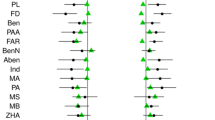Abstract
Heterodichogamy, the coexistence of morphs differing in the time when the shift between male and female phases occurs, is a rare sexual dimorphism derived from synchronous dichogamy. In dichogamous populations, plants need to adjust the temporal sex role to deal with the negative frequency dependent selection imposed by population sex ratios. However, such temporal adjustment may be constrained in dichogamous species with bisexual flowers and short floral longevities (<2 days) and therefore the reciprocal floral strategy can easily invade the population, ultimately leading to heterodichogamy. We predict that heterodichogamy has evolved in species with short floral longevities. To test this prediction, we compiled data on floral longevity for 377 dichogamous and heterodichogamous species with bisexual flowers and ran a phylogenetic logistic regression between floral strategy (dichogamy/heterodichogamy) and floral longevity. The results showed that heterodichogamous species had significantly shorter floral longevities than dichogamous species. This result together with the fact that evolutionary transitions always occurred from dichogamy to heterodichogamy supports the conclusion of the existence of a significant and negative evolutionary correlation between the floral longevity and the probability to evolve heterodichogamy from dichogamy in bisexual species. We discuss that the rarity of heterodichogamy in nature may be the result of other selective pressures towards long floral longevity in dichogamous species.


Similar content being viewed by others
References
Ashman T-L, Schoen DJ (1994) How long should flowers live? Nature 371:788–791
Bertin RI, Newman CM (1993) Dichogamy in angiosperms. Bot Rev 59:112–152
Brunet J, Charlesworth D (1995) Floral sex allocation in sequentially blooming plants. Evolution 49:70–79
Chaw SM (1992) Pollination, breeding syndromes, and systematics of Trochodendron aralioides Sieb. & Zucc. (Trochodendraceae), a relictual species in Eastern Asia. In: Peng CI (ed) Phytogeography and Botanical Inventory of Taiwan. Institute of Botany, Academia Sinica Monograph Series No 12. Taipei, pp 63–77
Drummond AJ, Rambaut A (2007) BEAST: Bayesian evolutionary analysis by sampling trees. BMC Evol Biol 7:214
Fukuhara T, Tokumaru S (2014) Inflorescence dimorphism, heterodichogamy and thrips pollination in Platycarya strobilacea (Juglandaceae). Ann Bot 113:467–476
Gao J, Xiong YZ, Huang SQ (2015) Effects of floral sexual investment and dichogamy on floral longevity. J Plant Ecol 8:116–121
He, HX (2006) Pollination biology and breeding system of the Endangered Chinese Endemic Kingdonia uniflora (Ranunculales). Master’s Thesis, Shaanxi Normal University
Ho LST, Ane C (2014) A linear-time algorithm for Gaussian and non-Gaussian trait evolution models. Syst Biol 63:397–408
Ishii HS, Harder LD (2012) Phenological associations of gender with floral morphology and integration in protandrous Delphinium glaucum. J Ecol 100:1029–1038
Ives AR, Garland T Jr (2010) Phylogenetic logistic regression for binary dependent variables. Syst Biol 59:9–26
Ives AR, Garland T (2014) Phylogenetic regression for binary dependent variables. In: Garamszegi LZ (ed) Modern phylogenetic comparative methods and their application in evolutionary biology. Springer, New York, pp 231–261
Kuhn TS, Mooers AØ, Thomas GH (2011) A simple polytomy resolver for dated phylogenies. Methods Ecol Evol 2:427–436
Lloyd DG, Webb CJ (1986) The avoidance of interference between the presentation of pollen and stigmas in angiosperms. I. Dichogamy. N Z J Bot 24:135–162
Maddison WP, Maddison DR (2015) Mesquite: a modular system for evolutionary analysis. Version 3.04. http://mesquiteproject.org
Pannell JR, Verdú M (2006) The evolution of gender specialisation from dimorphic hermaphroditism: paths from heterodichogamy to gynodioecy and androdioecy. Evolution 60:660–673
Renner SS (2001) How common is heterodichogamy? Trends Ecol Evol 16:595–597
Renner SS (2014) The relative and absolute frequencies of angiosperm sexual systems: dioecy, monoecy, gynodioecy, and an updated online database. Am J Bot 101:1588–1596
Sargent RD, Mandegar M, Otto SP (2006) A model of the evolution of dichogamy incorporating sex ration selection, anther-stigma interference and inbreeding depression. Evolution 60:934–944
Schoen DJ, Ashman TL (1995) The evolution of floral longevity: a resource allocation to maintenance versus construction of repeated structures in modular organisms. Evolution 49:131–139
Stevens P.F (2012) Angiosperm Phylogeny Website. Version 12. http://www.mobot.org/MOBOT/research/APweb/ Accessed 5 Jan 2016
Teichert H, Dötterl S, Gottsberger G (2011) Heterodichogamy and nitidulid beetle pollination in Anaxagorea prinoides, an early divergent Annonaceae. Plant Syst Evol 291:25–33
Wang X, Zhang P, Du Q, He H, Zhao L, Ren Y, Endress PK (2012) Heterodichogamy in Kingdonia (Circaeasteraceae, Ranunculales). Ann Bot 109:1125–1132
Webb CO, Ackerly DD, Kembel SW (2008) Phylocom: software for the analysis of phylogenetic community structure and character evolution. Bioinformatics 24:2098–2100
Wikström N, Savolainen V, Chase MW (2001) Evolution of the angiosperms: calibrating the family tree. Proc R Soc Lond B 268:2211–2220
Acknowledgments
The authors gratefully acknowledge Dr. R. Bertin for kindly providing the database of dichogamous species and S. Renner and two anonymous reviewers for comments on the manuscript. S.S gratefully acknowledges funding support from Supported by the Fundamental Research Funds for the Central Universities (lzujbky-2015-89).
Author information
Authors and Affiliations
Corresponding author
Electronic supplementary material
Below is the link to the electronic supplementary material.
Rights and permissions
About this article
Cite this article
Sun, S., Verdú, M. Evolutionary correlation of heterodichogamy and floral longevity. Evol Ecol 30, 1023–1030 (2016). https://doi.org/10.1007/s10682-016-9865-0
Received:
Accepted:
Published:
Issue Date:
DOI: https://doi.org/10.1007/s10682-016-9865-0




